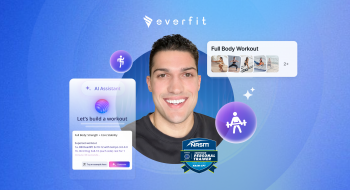Trevor Short is an exercise physiologist at the University of Hawaii, previous coach to NFL / Olympic athletes, & previous COO of a multi-million dollar training studios. Now he’s teaching you the essential concepts of designing a fitness program. You’ll learn how to perform a needs analysis & a comprehensive assessment, the foundational principle of designing a fitness program, and ancillary topics in exercise prescription. Learn the essentials of programming to the next level with these key considerations.
Transcript
And to wrap up, we’re going to talk about exercise prescriptions for conditioning. So there’s lots of different ways to prescribe exercises for conditioning. And I’m using conditioning as a really, really broad term. But this is really your metcon type conditioning at the end of a training session, right? But training models based on max number of repetitions or rounds have really been increasing in popularity. Okay, so yeah, AMRAP workouts EMOM workouts, right? These things are really, really getting popular in the fitness community. So the benefits include exercise prescriptions for groups, pre post data, and it accounts for intra-set fatigue that allows individuals to rest and recover into sets. However, there are some problems considerations, not huge ones, but it’s hard to control and, and really, like, it’s hard to control the magnitude of the training load. And what I mean by that is, if you have a AMRAP workout, right or EMOM workout, let’s say, EMOM is a little easier to explain. So let’s say you’re doing every minute on the minute, and you’re having people do, let’s say, 20, jump squats, right, and then they change to a different exercise. So for individuals that are relatively more fit, they might finish those 20 jump squats earlier, which means that they have more time to rest than an individual that’s relatively less fit, right, because you’re doing every minute on the minute, you basically have to complete this exercise within the minute. And then you get however long is left to rest, right. So EMOM is a really, really great thing. There’s nothing against EMOM on but what you need to consider and at least be aware of, is that really controlling the magnitude of the load, as well as rest interval characteristics are really challenging within that specific type of program design. Okay, so EMOM, every minute on the minute training, does challenge individuals with lower levels of fitness, it is a little more challenging for individuals of lower levels of fitness, because they might not be able to complete everything as quickly as somebody that’s more fit. Doesn’t mean that you don’t prescribe that for them. It just means that if you’re in a group setting that you’re aware of, keep an eye on the individuals that are possibly less fit, maybe cutting them off early, and so on, just pivoting, just being aware, is really going to help you out in this setting, okay. AMRAP workouts as many repetitions as possible. Okay, so AMRAP workouts are used in research to measure volitional fatigue. Okay, so an AMRAP workout is a lot different than a set to failure. So an AMRAP workout is when you’re doing, okay, you’re going to do as many of these as you can, in five minutes, you’re going to do as many of these as you can, and so on. AMRAP, as many reps as possible, as a training set to failure is what’s used in volitional fatigue research papers to identify when someone reaches fatigue. Okay, so I want to make sure there’s a clear difference between an AMRAP workout for maybe time, or training to failure at the end of a set, which that type of as many reps as possible, is used to measure volitional fatigue in research. AMRAP is a really, really effective training strategy to use. However, it could increase the risk of injury. If you’re not really familiar with your athlete and the training load that they’re able, how much stress is this individual able to handle? Okay, so you want to make sure that you really come correct with the training volume, if you are prescribing AMRAP workouts.
Another way to prescribe exercises for conditioning: timed workouts. I like timed workouts, so let’s say 30 seconds of the bike, for example. So 30 seconds of the assault bike, followed by 30 seconds of the rope, that in itself is going to have a really, really high glycolytic energy system stress. So timed workouts can be assigned for specific bioenergetic system stress, a.k.a. faster than the system, 10 to 15 seconds, right? All out ropes for 15 seconds, no holding back. Okay, that’s a really, really good way to test that type of system. So if you are prescribing exercises, for a group that needs to improve a certain bioenergetic system, then it’s really, really critical to use timed workouts because with the timed workouts, you can also have a predetermined work to rest ratio that I talked about earlier. And with that, that takes us directly into the next type of workout: interval workouts. So with interval workouts, you have predetermined work to rest ratios and load or AMRAP. Something really important, really popular, for example, is Tabata 20 seconds on 10 seconds off. If you’ve ever done a Tabata workout, they’re definitely incredibly demanding. And they’re usually demanding because you have a two to one work to rest ratio, whereas the NSCA never suggests going higher than one to one. It means that you’re doing twice the work as the rest that you’re getting, which means that your body is going to gas out relatively quickly, right? This is good if you’re able to manage the training, volume and load and if you’re aware with a proper needs analysis of the type of training stimulus that the individuals in your group or clients need, so it has to be really specific to the needs of that individual. Okay. So, with that exercise prescription for conditioning overall, there’s a lot of ways to prescribe exercises for conditioning. They’ve gotten really popular. I think the most valuable one to consider is usually the interval workouts or the timed workouts. And then just be careful with AMRAP workouts just because it does increase the risk of injury for some individuals when they’re going to failures. Right. And then EMOM workouts are really great. I absolutely love them. You just want to keep an eye on and be aware of its challenge that it places on individuals with lower levels of fitness.















